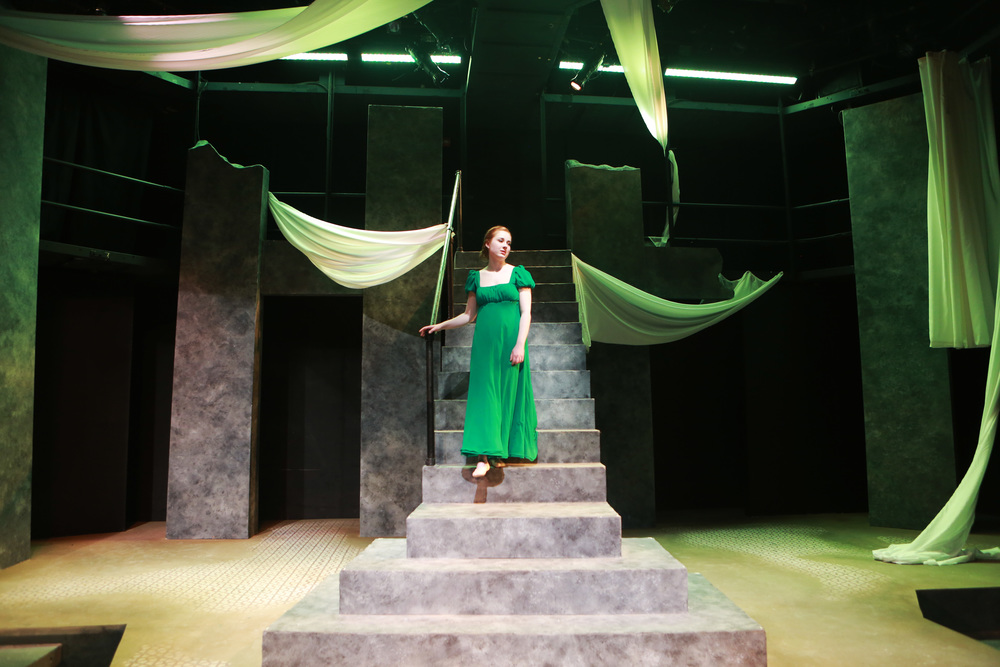
Giving Voices To The Voiceless
By: Gabe Cohn ’16
Twelve women rush the stage like a pack of wild animals. Indignant over deeds done in a distant past, their minds are restless even years after leading a life of servitude at the hands of Odysseus. Wronged by their master, abused by their patriarchal society, and eager for justice, the women pace the stage draped with the same worn linens they wore to the gallows centuries before. Their desperate glares pierce the audience from three directions. A battle cry, “Let him never be at rest,” rings out, and, with near-imperceptible synchronism, the women quickly draw their fingers across their faces, leaving behind violent streaks of jet-black war paint. They could be lean Comanche war chiefs or, just as easily, juiced NFL hopefuls; they have thoroughly observed both societies from Hades, their eternal sarcophagus.
The imagery of the war paint streaks showcases one of the The Penelopiad’s key features: blending the past with the present. This aspect, very much inherent in playwright Margaret Atwood’s text, reflects clearly in the direction. Director Emily Moler ’15 explains that she was “sensitive to the aspects of Atwood’s play that align with Greek theater and the Odyssey, but also aware of the many aspects that diverge from the traditional.” And this makes sense—the world of the Greek epic coexists seamlessly here with the more colloquial language and modern ideas presented by the play, which manifest themselves in the reflective mode of storytelling. Told from the perspective of Penelope (Lily Donahue ’15), the main storyline follows the eponymous character and twelve maids as they await the return of Odysseus from his Odyssey. The play offers an alternate perspective on the oft-told legend, giving new significance to Penelope’s storyline and, by extension, the women’s perspective.
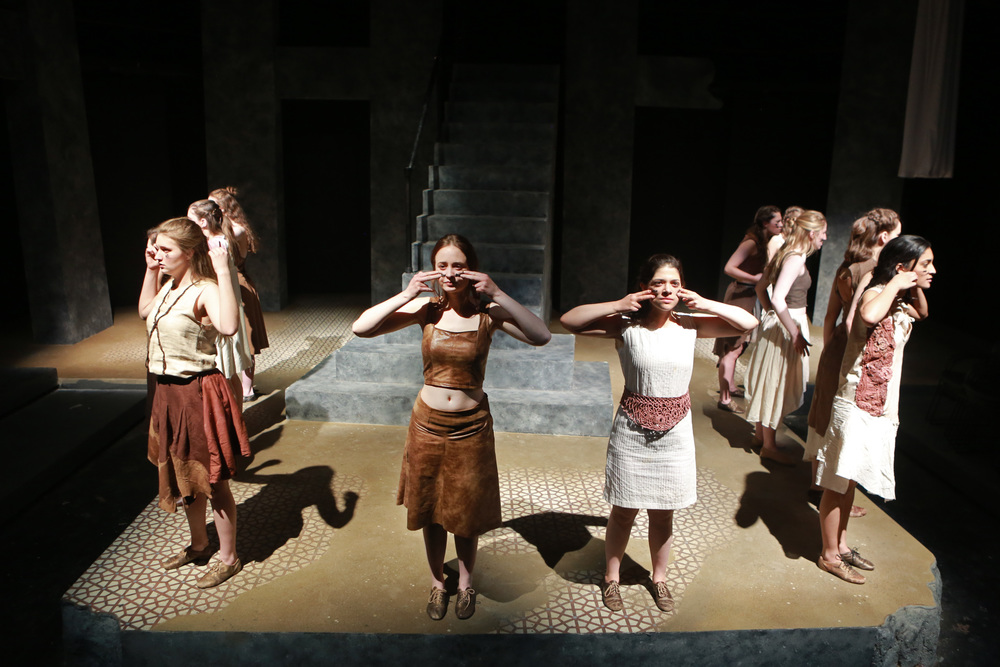
Featuring an entirely female cast, The Penelopiad gives a strong voice to Penelope’s maids—previously voiceless in the original storyline. It is clearly established early in the production that Penelope and her maids are telling a story of the past from the perspective of the present. Through this position, the play’s main storyline becomes a conscious reenactment. Penelope shifts between a present narrator and a past character, with the maids taking on the role of both themselves, the male characters, and other female characters. Donahue recounts the experience of playing both the “past” and “present” Penelope: “We don’t actually see Penelope at 15, we see a dead woman playing at being a young girl; her physicality, her voice–all of the ‘young’ scenes that we see in the play are Penelope’s own recreations. I tried to differentiate that from the older, composed woman she grows into.”
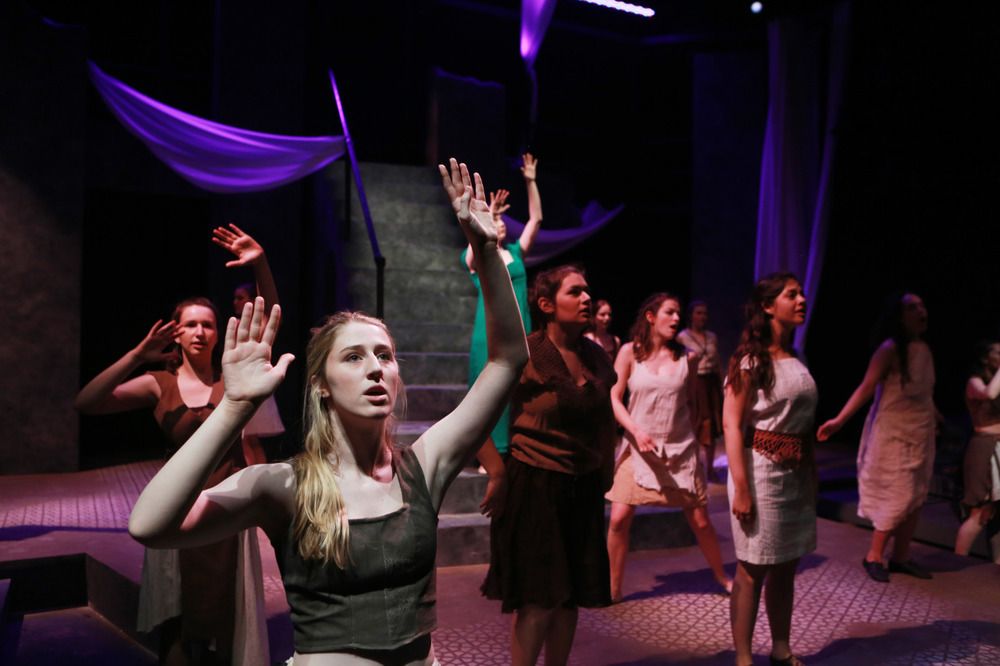
Lindsay Nuckel ’17, Hannah Baker ’16, Rachel Karp ’17, and Molly Burdick ’17
Evy Yergan ’16 spoke to her own portrayals of both the hyper-masculine Odysseus and female-identifying Narcissa, insisting that “Odysseus is masculine, not because he was born that way but because he was raised to be that way, the same reason that Narcissa is ‘feminine.’ I played Odysseus as a person who had to fit into the mold of his culture in order to succeed, for better or for worse. To do this he must be the things that we attach to masculinity: powerful, strong, large, intelligent, direct, confident, etc. Narcissa has to be essentially the opposite. But she and the other maids find ways to escape their societal roles as feminine by obtaining power and agency in secrecy or in the afterlife.” This hyper-masculine power, strength, and largeness necessitated a consciousness of physicality on the part of the actors at a level rarely seen on Skidmore stages.
The contempt each maid felt for the suitors came through clearly in their portrayal of them. Embracing a male caricature, the maids relished in their ability to exaggerate the ignorant excessiveness of the suitors’ hyper-masculinity. Through this, the maids used humor as a weapon against the oppression of their patriarchal society, and in that sense empowered themselves. Rebecca Zipursky ’15, who played both the mentor-like maid Klytie and the despicable suitor Antinuous, talked about the differing types of strength within the masculine and feminine characters: “The maids trusted Klytie to portray Antinuous, a man of brutal and terrifying hyper-masculine strength. This told me immediately that Klytie possessed her own compassion and strength of character which allowed her to tell the stories her fellow maids (practically her sisters) felt they could not. These two perceptions of strength are among the elements I was playing with when performing these two characters.”
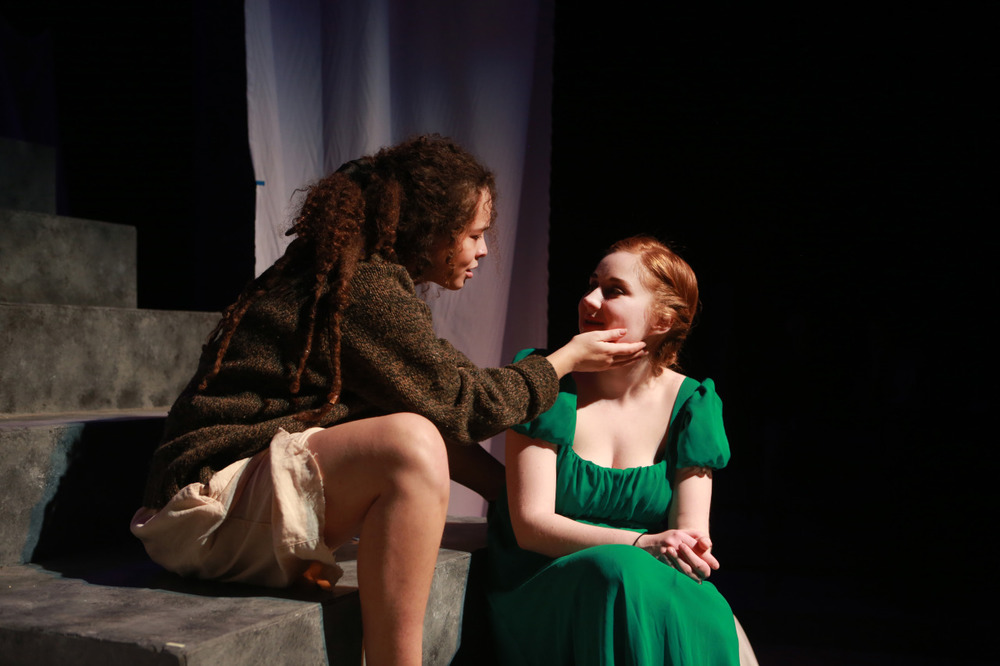
Evy Yergan ’16 and Lily Donahue ’15
Differentiating the masculine and feminine was also helped by the exquisitely designed costumes from Alli Green ’15, which dealt with gender distinctions and toyed with divisions of class and power. The male costumes were designed with broad shoulders, making the characters identifiable solely by their silhouettes. “I wanted to reverse the female silhouette/female attributes to make exaggerated ‘man-monsters,’” says Green, “So whereas the females in the show use their hands a lot and women have hips as our centers of gravity, all the suitors had emphasized shoulders, with their hands almost always totally lost in gloves and sleeves.” Penelope herself donned a neo-classical dress in brilliant emerald green, evoking a style steeped in a fascination with revitalizing the past and introducing a clear distinction of class.
The set, designed by James Barber ’15, was another key in creating the world of The Penelopiad. Barber explained that “embracing the architecture of the space” was paramount to his vision for the multi-leveled set, whose stone columns dwarf the space. But these columns, which went against tradition with their stern rectangular angles and concrete-like textures, would conjure up images of a destroyed futuristic society sooner than they would an ancient one. The raised stage, too, embraced the balance between the old and the new. Barber elaborates: “The dichotomy between the contemporary vs. the modern is a really nice way to frame a theatrical space. There needed to be some sort of specificity there.”
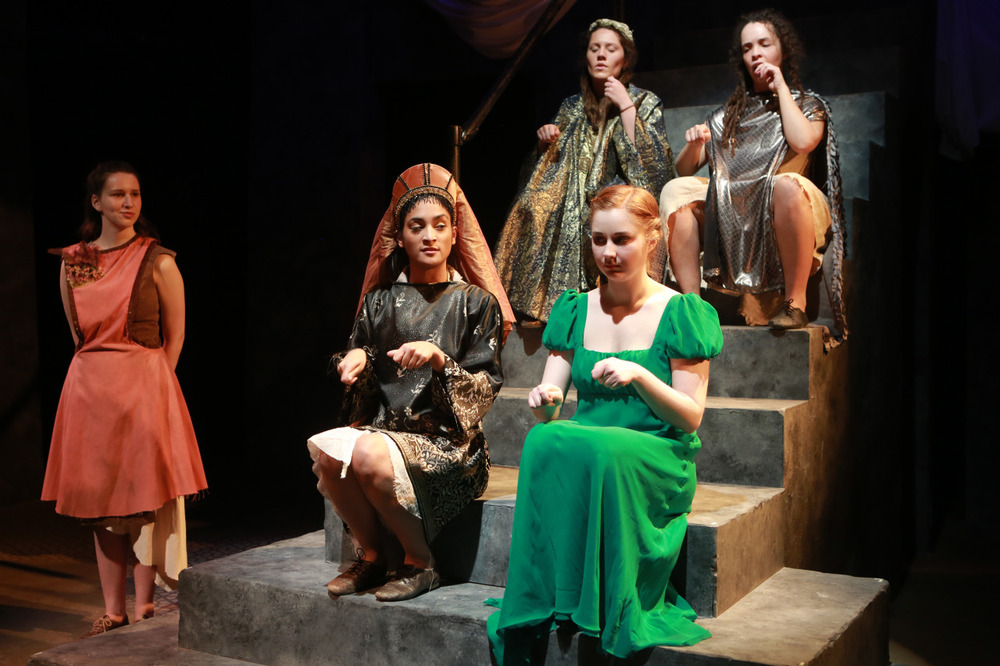
Sarah Rabinowitz ’17, Brittney Volcy ’15, and Lily Donahue ’15
Of course, the world of The Penelopiad would have been incomplete without the musical contributions from Jarred Green ’15. “The process was very organic,” he tells me, “both mine and Emily’s visions had time to grow from each other.” Green’s choral compositions brought to life the lyrics found in Atwood’s text, and the instrumentals helped to both give unique character to and distinguish between the modern Hades and ancient Ithaca. “To keep the Hades music sounding both modern and ominous,” he says, “I took recordings of the instrumental and choral music from rehearsal and slowed down certain snippets to about 1/20th of the speed. This provided a stark contrast to the other incidental music and gave audiences a chance to hear the overtones produced by each chord.”
The amount of creativity and passion at work evident in the development of The Penelopiad speaks volumes not only to the sheer talent of the students involved, but also the environment of collaboration that was at the heart of Moler’s process. “I wanted to create an environment where everybody felt comfortable proposing their own ideas,” she explained, pointing to the great strength of student-directed black box productions: the ability for each student’s voice to shine through, giving all involved a tangible sense of ownership. For The Penelopiad, success counted on this concept. In her final monologue, Penelope speaks of her lack of desire to return to the world of the living—the present-day—saying: “I can see that the world is just as dangerous as it was in my day.” The line, which shatters the dichotomy between old and new, is what gives The Penelopiad its striking relevance, and it is this relevance which pulses through every vein of this production. Walking out of the theater, the audience is not stuck dissecting the mythic past, but instead is made to look at their own society afresh. And this, after all, is the greatest goal theater of any caliber can hope to achieve.
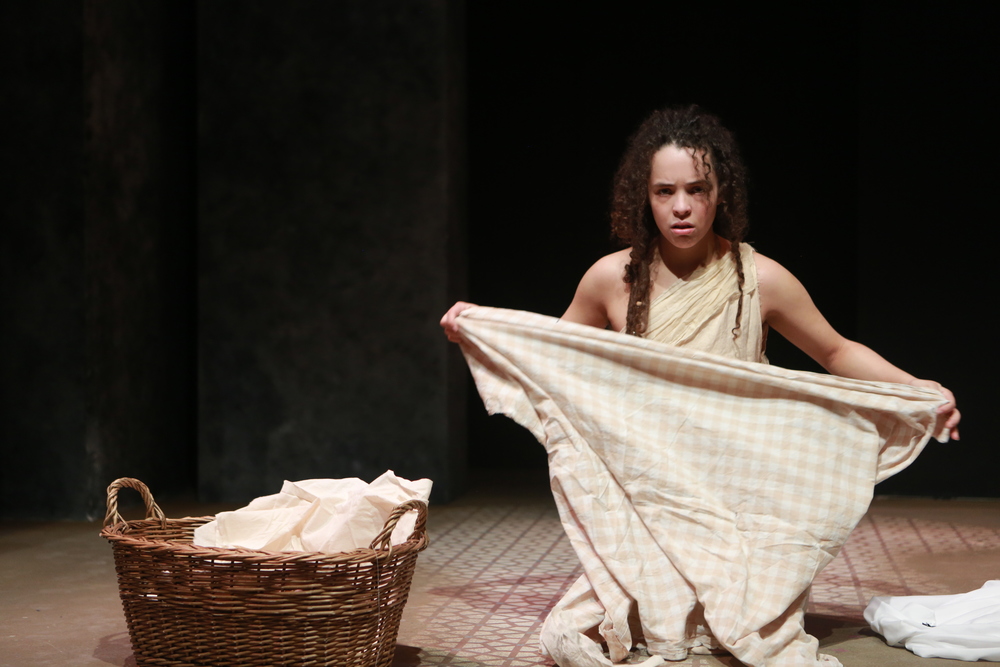
This article originally appeared in print in the Spring 2015 Skidmore Theater Newsletter.
